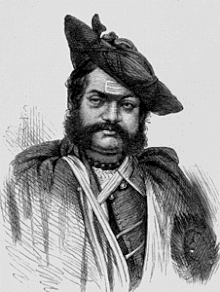Jayajirao Scindia
| Jayajirao Scindia | |
|---|---|
| Maharaja Scindia of Gwalior | |

"The Maharajah Scindia of Gwalior" as seen in the Illustrated London News, 1875
|
|
| Reign | 7 February 1843 – 20 June 1886 |
| Predecessor | Jankojirao II Sindhia |
| Successor | Madho Rao Scindia |
| Born | 19 January 1843 Gwalior |
| Died | 20 June 1886 (aged 51) Jai Vilas Palace, Lashkar |
| Spouse | Chimnaraje (in 1843) Laxmibairaje (in 1852) Babuibai raje (in 1873) Sakhyaraje (in ?) |
| Issue | five sons and four daughters |
| House | Scindia family |
| Father | Jankoji Rao Scindia II |
| Mother | a sister of Shrimant Sardar Devrao Jadhav |
Jayajirao Scindia (19 January 1843– 20 June 1886) of the Scindia dynasty of the Marathas was the ruling Maharajah of Gwalior from 1843 to 1886 under the British rule.
Jayajirao was born as Bhagirath Shinde, son of Hanwant Rao on 19 January 1835. The erstwhile Maharaja of Gwalior, Jankojirao II, died in 1843 without leaving an heir leading his widow Tara Bai to adopt Bhagirath Rao. Bhagirath Shinde succeeded the Gwalior gaddi under the name of Jayajirao Sindhia on 22 February 1843. Mama Sahib, the maternal uncle of Jankojirao II, was chosen as regent. originally shinde family shrigonda (ahmednagar maharashtra).
Dada Khasgiwale, the comptroller of the Shinde household overthrew Mama Sahib as the regent nearly leading to a civil war. The British East India Company decided to interfere by withdrawing their Resident Colonel Alexander Speirs and demanding the surrender of Dada Khasgiwale was demanded. A British force under Sir Hugh Gough moved on Gwalior, and crossed the Chambal in December 1843. On 29 December followed the simultaneous battles of Panniar and Maharajpur, in which the Gwalior army was annihilated. Khasgiwale was arrested by the British and was sent to Benares Jail where he died in 1845.
A treaty was then made, under which certain lands to the value of 1.8 million, including Chanderi District, were ceded for the upkeep of a contingent force, besides other lands for the liquidation of the expenses incurred in the war, the State army was reduced, and a Council of Regency was appointed during the minority, to act under the resident's advice.
When in 1857, the Indian rebellion against the British began, Jayajirao, whose ancestors had fought and been defeated by them, was known as a good friend of the British. However, his minister, Dinkar Rao, along with Major Chartres Macpherson, the British representative to Gwalior, convinced him to initially stay neutral and later to side with the British, despite unrest amongst his troops and his people who wanted to join the rebels.
On 1 June 1858 Jayajirao led his forces to Morar to fight a rebel army led by Tatya Tope, Rani Lakshmibai and Rao Sahib. This army had 7,000 infantry, 4,000 cavalry and 12 guns while he had only 1,500 cavalry, his bodyguard of 600 men and 8 guns. He waited for their attack which came at 7 o'clock in the morning; in this attack the rebel cavalry took the guns and most of the Gwalior forces except the bodyguard went over to the rebels. The Maharaja and the reminder fled without stopping until they reached Agra.
...
Wikipedia
